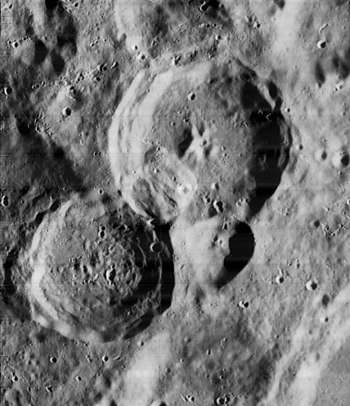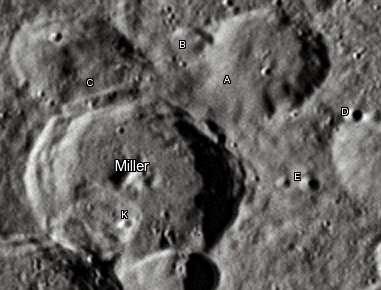Miller (crater)
 Lunar Orbiter 4 image showing Miller (upper right) and Nasireddin (lower left) | |
| Coordinates | 39°18′S 0°48′E / 39.3°S 0.8°ECoordinates: 39°18′S 0°48′E / 39.3°S 0.8°E |
|---|---|
| Diameter | 75 km |
| Depth | 3.5 km |
| Colongitude | 0° at sunrise |
| Eponym | William A. Miller |
Miller is a lunar impact crater that lies amidst the rugged terrain in the southern part of the Moon. It is attached to the northern rim of the smaller crater Nasireddin, and the outer rampart of the latter reaches almost to the central peak formation at the midpoint of Miller's interior floor. Together with Huggins to the southwest and Orontius to the south-southwest, this foursome forms a chain of craters forming an arc that curves towards the north. The northwest rim of Miller in turn is attached to the satellite crater Miller C, forming the end of the arc. To the southeast lies Stöfler. The crater is named after British scientist William Allen Miller.
The rim of Miller is nearly circular with a system of terraces along the inner wall. The interior floor is nearly level with the aforementioned central peak formation located at the midpoint. The crater Stöfler H is attached to the exterior southeast rim and intrudes slightly into the interior. There are a few tiny craterlets lying within the crater, including one along the rampart of Nasiredden.
Satellite craters

By convention these features are identified on lunar maps by placing the letter on the side of the crater midpoint that is closest to Miller.
| Miller | Latitude | Longitude | Diameter |
|---|---|---|---|
| A | 37.7° S | 1.8° E | 39 km |
| B | 37.6° S | 1.0° E | 12 km |
| C | 38.2° S | 0.3° W | 36 km |
| D | 38.0° S | 3.1° E | 5 km |
| E | 38.8° S | 2.8° E | 6 km |
| K | 39.8° S | 0.9° E | 4 km |
References
- Wood, Chuck (October 16, 2007). "6 Degrees of Separation". Lunar Photo of the Day. Archived from the original on October 21, 2007. Retrieved 2007-10-16.
- Andersson, L. E.; Whitaker, E. A. (1982). NASA Catalogue of Lunar Nomenclature. NASA RP-1097.
- Blue, Jennifer (July 25, 2007). "Gazetteer of Planetary Nomenclature". USGS. Retrieved 2007-08-05.
- Bussey, B.; Spudis, P. (2004). The Clementine Atlas of the Moon. New York: Cambridge University Press. ISBN 978-0-521-81528-4.
- Cocks, Elijah E.; Cocks, Josiah C. (1995). Who's Who on the Moon: A Biographical Dictionary of Lunar Nomenclature. Tudor Publishers. ISBN 978-0-936389-27-1.
- McDowell, Jonathan (July 15, 2007). "Lunar Nomenclature". Jonathan's Space Report. Retrieved 2007-10-24.
- Menzel, D. H.; Minnaert, M.; Levin, B.; Dollfus, A.; Bell, B. (1971). "Report on Lunar Nomenclature by the Working Group of Commission 17 of the IAU". Space Science Reviews. 12 (2): 136–186. Bibcode:1971SSRv...12..136M. doi:10.1007/BF00171763.
- Moore, Patrick (2001). On the Moon. Sterling Publishing Co. ISBN 978-0-304-35469-6.
- Price, Fred W. (1988). The Moon Observer's Handbook. Cambridge University Press. ISBN 978-0-521-33500-3.
- Rükl, Antonín (1990). Atlas of the Moon. Kalmbach Books. ISBN 978-0-913135-17-4.
- Webb, Rev. T. W. (1962). Celestial Objects for Common Telescopes (6th revised ed.). Dover. ISBN 978-0-486-20917-3.
- Whitaker, Ewen A. (1999). Mapping and Naming the Moon. Cambridge University Press. ISBN 978-0-521-62248-6.
- Wlasuk, Peter T. (2000). Observing the Moon. Springer. ISBN 978-1-85233-193-1.
| Wikimedia Commons has media related to Miller (crater). |